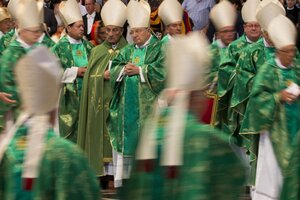Will the Vatican make it easier to be a divorced Catholic?
Pope Francis’s love-first-preach-later approach faces a major test at this week’s Synod, where bishops from around the world will debate how to welcome divorcees to the Church.

Bishops and cardinals leave at the end of the opening Mass of the Synod of bishops, celebrated by Pope Francis in St. Peter's Basilica, at the Vatican on Sunday. Bishops will debate how to respond to parishioners with controversial needs, including divorcees, cohabitating couples, and gay parishioners.
Alessandra Tarantino/ AP
There’s no such thing as a Catholic divorce, but there certainly are Catholic divorcees.
That's what Pope Francis reaffirmed on Sunday, the first day of a three-week Bishops’ Synod held in Rome that addressed the need to minister to modern families, particularly Catholics separated from their spouses, a group that includes 11 million Catholics in the United States alone.
“A church with closed doors betrays herself and her mission and instead of being a bridge, becomes a roadblock,” Francis said.
This shift in the tone, if not the substance, of the church's stance on divorce should come as no surprise. Since the beginning his papacy in March 2013, Francis has repeatedly insisted that the church be more welcoming, particularly to those who may have been alienated by the Vatican's social teachings.
The recent fracas over gay marriage, which the Church staunchly opposes, and the contested meaning of the Pope’s visit with Kim Davis may have overshadowed another group who say they’ve received the cold shoulder from the church: Catholic divorcees.
This group may feel more welcome after a series of reforms Francis pushed through in September. But will this week’s Synod make further progress, or will conservatives rein in what they consider reckless change?
Nicole Winfield of the Associated Press suggests that conversations about divorce may make more headway than those on gay marriage, though “sparks are expected to fly” no matter what.
Maintaining that marriage is a permanent union, the Catholic Church does not countenance divorce; rather, Catholics who wish to end their marriages may apply for annulment in an often lengthy process that requires paperwork and testimony before a tribunal. Annulment does not end a marriage, per se, but rather proves that the union was invalid from the start.
For some divorcees, particularly women, the experience may feel intrusive, or even dishonest, according to a New York Times report. “You’re dealing with an abusive husband who is male, and then you have to go to a male to get the annulment, and a bunch of males sit at a table and decide whether your decision was correct,” one woman told reporter Michael Paulson. Others object to the logic of "invalidating." “I entered into [marriage] with the right ideas, and to say different would be a lie,” another explained.
According to the Center for Applied Research in the Apostolate at Georgetown University, roughly 20 percent of Catholics in the US will experience civil divorce. Of those, only 15 percent go through the church's annulment process.
Without an annulment, divorced Catholics may not marry again in the church. Those who do remarry are barred from taking Communion, which the Catechism of the Catholic Church calls “the source and summit of the Christian life.” They are technically considered adulterers.
Francis declared a series of changes this fall to ease the annulment process, limiting its costs and time. But offering Communion to remarried Catholics without an annulment remains a hurdle.
“It’s quite impossible” to change the Church’s teachings on Communion, Vatican finance manager Cardinal George Pell told the Associated Press last week at a conference “about helping gays overcome their homosexual tendencies.”
Meanwhile, however, more progressive factions in Rome have suggested designing a “path of penance” for remarried Catholics, after which they could again receive the host.
A hallmark of Francis’s papacy has been seeking to overcome the gap between church teachings and Catholics’ daily lives. But is the rest of the Vatican ready to bridge this gap?
“It’s very clear which direction he is going in – the path of inclusion,” Vatican analyst Gerry O’Connell told the Telegraph. “[But] he has got to find a way to bring the whole Church with him.”

